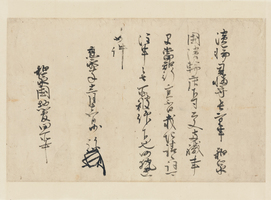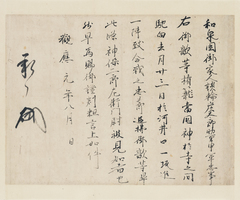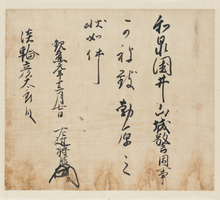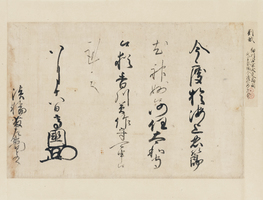Scroll One: The Tannowa and their Kujō Proprietors
The first scroll of the Tannowa records reveals the residual powers of proprietors, the Kujō family, who were of the Fujiwara lineage and served as regents to the throne. Confusingly, the Kujō appointed one of their lesser relatives as the azukari dokoro or manager, who directed other lower ranking managers, such as those with the title gesu. The oldest documents (1-1 and 1-2) are fascinating, famous, and opaque. A warrior named Kaneshige had been appointed to the prestigious title of jitō, or land steward, the most prized offices of warriors in Kamakura Japan. Kaneshige’s claims were either spurious, or for whatever reason he was disposed of this office. The Kujō azukari dokoro allowed him to informally collect taxes, however, at a rate as if he were jitō. When this was discovered, Kaneshige was castigated and the Kujō azukari dokoro lost his post as well.
Later documents recount yet another family, the Tannowa, who took the name of the estate. They were appointed to another office, that of kumon, in 1237 (doc. 1-3), which meant that they were responsible for writing records for use at the estate. The hereditary nature of this post was confirmed in 1249 (1-4) and further investitures exist from 1262 and 1298 (1-5, 1-6), and the Tannowa continued holding it in the thirteenth and fourteenth centuries. The onset of civil war from 1333-92 found many Kujō serving the Southern Court, and they still continued to assess taxes on these lands through the 1360s. At times, they had to provide funds for the Kujō to engage in Southern Court New Year’s rites and borrowed to secure them (doc. 1-13). The Kujō maintained proprietary rights over these lands through the 1360s, and finances from Tannowa supported the Southern Court. From the Kujō perspective, particularly those allied with the Southenr Court, the Tannowa continued to be the Estate Secretary (kumon) of the estate. Nevertheless, Go-Daigo’s short lived Kenmu Regime, which supplanted the Kamakura warrior government, appointed a Tannowa to the more prestigious title of azukari dokoro in 1334. By 1392, however, the Southern Court had collapsed, and in 1403, officials of the triumphant Ashikaga bakufu tried to adjudicate which member of the Tannowa controlled the offices of Estate Secretary (kumon) and manager (gesu). For more on this dispute, see Scroll Five.
Scroll Two: The Tannowa and Kusunoki Masanori
Scroll two contains ten Tannowa documents linked to the Kusunoki family. Kusunoki Masashige was a famous Southern Court general who died fighting the Ashikaga in 1336. His eldest son Masatsura died in 1348, and his younger, Masasnori, took up the cause after 1348. Masanori’s first record in this collection (2-1) dates from 1352, and recounts the turmoil accompanying the fracture of the Ashikaga regime in 1350. At that time, much of Izumi province became a battlefield, and key local warriors, among them the Sueki, Kashii, fortified castles (for the same names, see the oath of 5-1). Tannowa Sukeshige can be documented as attacking Iyama castle as well for the Southern Court. Ironically, from 1347 through 1350, the same Sukeshige fortified this castle for the Northern Court (docs. 3-11, 3-13). Docs. 2-2 through 2-4 and 2-6 through 2-10 were all in Masanori’s hand.
Masanori was most likely left-handed. This can be known when blocking off the lines of his handwriting in squares. A document written by a right-handed scribe, such as 1-12 (left) gradually slopes to the right, while Masanori’s document (2-4) gradually slopes to the left, which is only possible when writing with the left hand.
Masanori fought for the Southern Court in the 1350s, and while relatives such as Kusunoki Masaaki continued to fight for that cause in 1373 (doc. 2-5) Masanori can be documented as fighting for the Northern Court from 1374 (docs. 2-2 through 2-4) through 1380 (docs. 2-6 through 2-8). Nevertheless, Masanori’s position was tenuous, in that he did not control the Izumi region, and granted his Tannowa followers lands from Kawachi, his base instead. In 1380, his close ally with the Northern Court, Hosokawa Yoriyuki, lost power, and Masanori once again joined the Southern Court, fighting for them through 1386 (doc. 2-10).
Scroll Three: The Tannowa as Warriors
These documents are mostly from figures linked to warrior governments. The oldest (Tannowa 3-4), a 1324 order from Rokuhara, the branch office of the Kamakura shogunate, requests that the Tannowa fix a broken dyke. This document is interesting because the Tannowa did not have any close ties to Kamakura, but the protector (shugo) of the province included them on a roster for this work, and by doing so made them an official householder (gokenin) of the Kamakura regime, a position with responsibilities, but not particularly strong rights, although a degree of debt relief was granted to gokenin by Kamakura in 1297.
The next document dates from the tenth day of the fifth month of 1333, and shows that Tannowa Shōen, the same person who repaired the dyke in 1324, was now joining the army of Ashikaga Takauji, who turned on Kamakura, and destroyed its Rokuhara forces. The Kamakura bakufu itself collapsed the next year, and briefly, Go-Daigo founded his Kenmu regime, which made a Tannowa officially a manger (gesu) for the estate in 1334.
Ashikaga Takauji rebelled against Go-Daigo late in 1335, and by the seventh month of 1336, Tannowa Suketarō Shigeuji joined his forces (3-1). Shigeuji can be documented fighting for Takauji under the command of Hatakeyama Kunikiyo throughout much of 1336 and 1337 (docs. 3-6 and 3-7). In 1337, a nameless Southern Court commander invited Shigeuji to switch sides (3-8) but no evidence exists that he did join their cause, although he preserved this letter and another that he received in 1338 (3-9).
In 1347, Tannowa Hikotarō Sukeshige and a certain Tannowa Magotarō fought with Kō no Moroyasu, brother to Ashikaga Takauji’s chief of staff, and took the fight to the Southern Court capital of Yoshino, which was burned in 1348. It was referred to in a document as “Miyazato” or “The Palace Village”) (3-11). For their troubles Tannowa Magotarō received lands for military provisions (3-10) and fought for Hatakeyama Kunikiyo through the summer of 1350 (3-12).
Nevertheless, a rift in the Ashikaga regime caused Ashikaga Tadayoshi, Takauji’s chief of staff, to attack Kō no Moroyasu and Moronao in the eleventh month of 1350 (3-2). Sukeshige had long fought for Moroyasu, and he seems to have remained allied to their faction. Sukeshige performed guard duty as late as the seventh day of twelfth month of 1350 (3-13) under Hatakeyama Kunikiyo. At the end of that same month, however, Go-Murakami of the Southern Court enticed Sukeshige to switch sides (doc. 4-1) and he abandoned the fractured Ashikaga regime for the resurgent Southern Court. Document 2-1 reveals Sukeshige’s extensive fighting for the Southern Court in 1351-52.
After the death of Moronao, Moroyasu, and Tadayoshi, the Ashikaga once again reached out to Tannowa Sukeshige in the fourth month of 1352. Ashikaga Takauji’s son Yoshiakira promised Sukeshige that if he rejoined their side, he could maintain all of his land holdings (3-3). Through the sixth month of 1352, Sukeshige continued to fight for the Southern Court (2-1), but Tannowa Magogorō, presumably his son, was fighting for the Ashikaga by the fifth month of 1352. The Tannowa hedged their bets by fighting for both sides in the conflict.
Ashikaga Tadafuyu, an illegitimate son of Takauji who fought for the Southern Court, tried enticing Sukeshige to join his side in 1355 (3-15) but Sukeshige’s actions are not clear. Other Tannowa, named Tadashige and Muneshige, did fight for the Southern Court from 1354 through 1374 (Tannowa 4-2 through 4-8 and Tannowa 2-2). The Tannowa were allied with Southern Court General Kusunoki Masanori, who joined the Northern Court by the ninth month of 1374 (2-3, 2-4) and continued to fight with him and the Northern Court through 1380 (2-7, 2-8) When he rejoined the Southern Court, some Tannowa fought for this regime through 1391 (2-9, 2-10, 4-9).
With the 1392 Surrender of the Southern Court, the Tannowa appealed to the fact that some of their documents of investiture for their managerial (gesu) post was lost, and most of the warriors of Izumi (save for the Migita) signed an oath supporting their claims in 1396 (5-1). Ultimately triumphant Ashikaga officials decided that oaths to the effect of their office would count as proof in 1403 (1-15).
The last documents in the collection recount the Tannowa fighting against the forces of the Hatakeyama in central Japan in 1460 (3-16), and again in 1467 (3-17), where they participated in a major battle in Kyoto during the Ōnin War. The final document (3-18), although undated, most likely dates from 1517. It shows that the Tannowa fought Hosokawa Takakuni, and participated in naval campaigns on his behalf in the Inland Sea.
Scroll Four: The Tannowa and the Southern Court
This remarkable series of Southern court documents from the Southern Court Emperors Go-Murakami, Chōkei, and Go-Kameyama, the last Southern Court Emperor, as this 1391 document during the penultimate year of the Southern Court’s existence. The first document (4-1), from Go-Murakami, was so small (kogirigami) so as to be hidden by a messenger when traveling through enemy lines. It encouraged Tannowa Hikotarō to switch sides and fight for the Southern Court and his campaigns are most clearly recounted in document 2-1. Most of the other documents are promotions, made from recycled mulberry paper. As paper was dissolved to make this document (which is called shukushi) and was only issued for edicts by emperors or retired emperors. Document 4-2 is a classic examples of this paper, but documents 4-3 through 4-5 were colored with ink to give the distinctive grey appearance of these records but were not made from recycled paper. Other records, such as 4-8 or 4-9 were, unusually for imperial documents, were issued on white rather than grey paper, which shows the strain the Southern Court was under during its waning years, when they could not get hold of proper resources.
Scroll Five: The Tannowa Oath
Scroll five contains a single document. Apparently the Tannowa lost all of their documents that describe their gesu rights at Tannowa estate during the turmoil of the Ōan era (1368-75), when Kusunoki Masanori was allied to the Northern Court but could not adequately control Izumi (see Scroll Two). The major warriors of Izumi all signed this oath attesting to the existence of these records. This is unusually as such a document would be signed by the shugo or protector, who by this time was Ōuchi Yoshihiro. Yoshihiro can be documented as confirming other losses, but not the Tannowa and so this led to the Izumi warrior to band together and sign an oath in 1396. The scribe was, however, not skilled and the document has several errors in it, and otherwise represents a unique records of the time. This issue remained unresolved It most likely was linked to the request for an oath mentioned in document 1-15 of 1403, written after Ōuchi Yoshihiro was no longer shugo of the province, having been killed in 1399 when rebelling against the Ashikaga.
























































